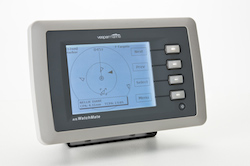Even if you believe you don't need one or it's an expense you can't afford, if your boat is 65 feet or longer, and you operate on any navigable U.S. waters, the Coast Guard is requiring you to have an automatic identification system.
The ruling, "Vessel Requirements for Notices of Arrival and Departure and Automatic Identification System" becomes effective March 2. However, you have until March 1, 2016 to install the AIS.
The Coast Guard is requiring commercial vessels 65 feet and longer that operate in U.S. waters to be equipped with an automatic identification system by March 1, 2016 under a new rule that becomes effective on March 2. Vesper Marine photoIf you aren't aware of this rule, you're not alone. Though the rule has been in the works for about 11 years, the Coast Guard hasn't done a very good job of publicizing it. I just spoke to a Coast Guard fishing vessel safety officer and he didn't become aware of the rule until about a week ago.
The Coast Guard says the purpose of the AIS requirement and the Notice of Arrival and Departure, which affects only commercial vessels 300 gross tons or less coming from a foreign port, "is to improve navigation safety, enhance the Coast Guard's ability to identify and track vessels, and to heighten the Coast Guard's overall situational and maritime domain awareness, which will enhance mariner's navigation safety and the Coast Guard's ability to address threats to maritime transportation security."
Commercial fishermen won't be alone in the Coast Guard's AIS rulemaking. It's estimated that 5,848 commercial boats are affected. Of that total, 2,906 are commercial fishing boats, the largest vessel group subject to the requirement. Another 1,429 tugs and other towing boats make up the next largest group of boats affected. The vessel groups occupying the bottom of the list are school boats —10 — and dredges at 17.
For those who haven't seen the benefit of AIS, the Coast Guard says it's "the most effective tool currently available to enhance a mariner's situational awareness and our own [maritime domain awareness]."
In the comment period to the proposed rulemaking, one concern from several people in the fishing industry was that having to install and use AIS meant that a fishing boat captain's hot spots would no longer be his secret; other boats would quickly join him.
However, the Coast Guard reasoned that the ability of an AIS unit to help a boat navigate safely superseded the need for someone to keep his favorite fishing spots secret.
From a financial standpoint, owners of commercial fishing boats 65 feet and longer did luck out in that they are only required to have class-B AIS and not class A, though they can if they want. That's opposed to other categories, such as passenger boats over 65 feet, which must have class-A AIS.
The Coast Guard figures an average class-B AIS unit costs about $700, whereas the average cost of a class-A unit is $3,230.







.jpg.small.400x400.jpg)